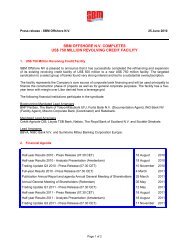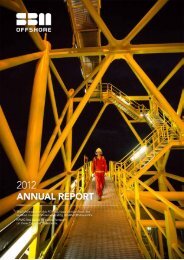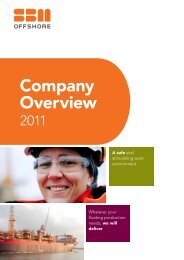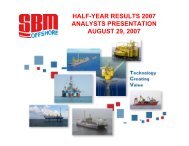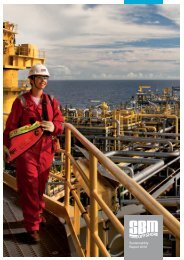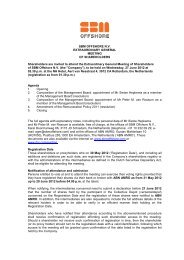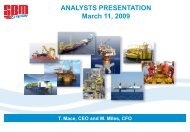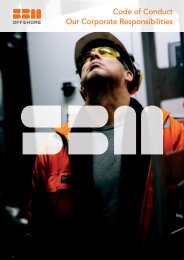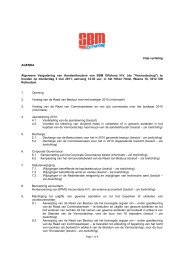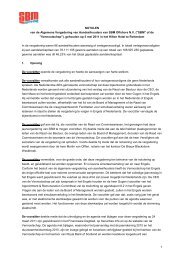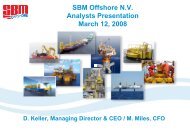Annual Report 2010 - SBM Offshore
Annual Report 2010 - SBM Offshore
Annual Report 2010 - SBM Offshore
You also want an ePaper? Increase the reach of your titles
YUMPU automatically turns print PDFs into web optimized ePapers that Google loves.
Financial Review / Financial Statements <strong>2010</strong><br />
transaction occurred during the year <strong>2010</strong>.<br />
• IAS 36 (amendment), ‘Impairment of assets’ (effective<br />
from 1 January <strong>2010</strong>). The amendment clarifies<br />
that the largest cash-generating unit (or group of<br />
units) to which goodwill should be allocated for<br />
the purposes of impairment testing is an operating<br />
segment, as defined by paragraph 5 of IFRS 8,<br />
‘Operating segments’. The change in accounting<br />
policy was applied prospectively and had no impact<br />
on the financial statements.<br />
(b) Standards, amendments and interpretations effective<br />
in <strong>2010</strong> but not relevant.<br />
The following standards, amendments and interpretations<br />
to published standards are mandatory for<br />
accounting periods beginning on or after 1 January<br />
<strong>2010</strong> but they are not relevant to the Company’s<br />
operations:<br />
• IFRIC 9 ‘Reassessment of embedded derivatives<br />
and IAS 39, Financial instruments: Recognition and<br />
measurement’ (effective from 1 July 2009).<br />
• IFRS 1 (amendment), ‘First time adoption of IFRS’<br />
(effective from 1 January <strong>2010</strong>)<br />
• IFRS 2 (amendment), ‘Share-based Payments,<br />
Group Cash-settled Share-based Payments’<br />
(effective from 1 January <strong>2010</strong>).<br />
• IAS 32 (amendment), ‘Financial Instruments:<br />
Presentation, Classification of rights issues’<br />
(effective from 1 February <strong>2010</strong>).<br />
• IFRIC 19, ‘Extinguishing Financial liabilities with<br />
Equity’ (effective from 1 July <strong>2010</strong>).<br />
(c) Standards, amendments and interpretations to<br />
existing standards that are not yet effective and have<br />
not been adopted early by the Company.<br />
• IFRS 9, ‘Financial Instruments’ (effective from 1<br />
January 2013).<br />
(d) Standards, Amendments and interpretations to<br />
existing standards that are not yet effective and not<br />
relevant.<br />
• IAS 24 (amendment) 'Related party disclosures'<br />
(effective from 1 January 2011).<br />
116 <strong>SBM</strong> <strong>Offshore</strong> – <strong>Annual</strong> <strong>Report</strong> <strong>2010</strong><br />
• IFRIC 14 (amendment) 'IAS 19 - The limit on a<br />
defined benefit asset, minimum funding requirements<br />
and their interactions' (effective from 1<br />
January 2011)<br />
Consolidation<br />
Subsidiaries<br />
Subsidiaries are entities (including special purpose entities)<br />
controlled by the Company. Control exists when<br />
the Company has the power, directly or indirectly, to<br />
govern the financial and operating policies of an entity<br />
so as to obtain benefits from its activities generally<br />
accompanying a shareholding of more than one half of<br />
the voting rights. Potential voting rights that presently<br />
are exercisable or convertible are considered when<br />
assessing whether the Company controls another<br />
entity. The figures of the subsidiaries are included in the<br />
financial statements from the date that control commences<br />
until such control ceases.<br />
The purchase method of accounting is used to account<br />
for the acquisition of subsidiaries by the Company.<br />
The cost of an acquisition is measured as the fair value<br />
of the assets given, equity instruments issued and<br />
liabilities incurred or assumed at the date of exchange.<br />
Identifiable assets acquired and liabilities and contingent<br />
liabilities assumed in a business combination are<br />
measured initially at their fair values at the acquisition<br />
date, irrespective of the extent of any non-controlling<br />
interest. The excess of the cost of acquisition over the<br />
fair value of the Company's share of the identifiable net<br />
assets acquired is recorded as goodwill. If the cost of<br />
acquisition is less than the fair value of the net assets<br />
of the subsidiary acquired, the difference is recognised<br />
directly in the income statement.<br />
Transactions and non-controlling interests<br />
The Company applies a policy of recognizing trading<br />
transactions with non-controlling interests as transactions<br />
with external parties. Disposals to non-controlling<br />
interests result in gains and losses for the Company<br />
and are recorded in the income statement. Purchases<br />
from non-controlling interests result in goodwill, being<br />
the difference between any consideration paid and<br />
the relevant share acquired of the carrying value of net<br />
assets of the non-controlling interest.



